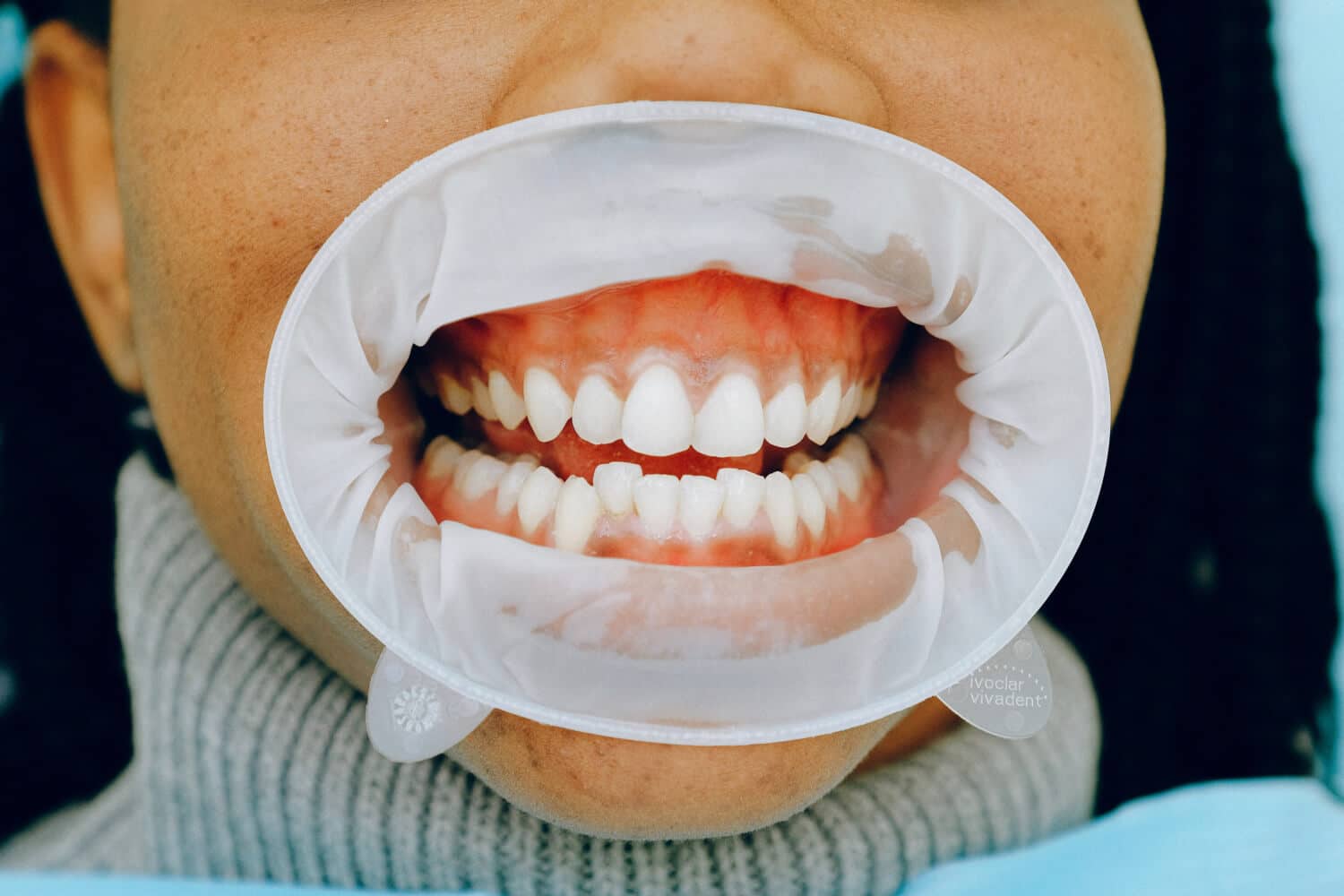White Spots on Teeth? How We Can Help!
Ever noticed those pesky white stains on teeth, or white areas on teeth that seemingly refuse to go away? You’re not alone. These unsightly spots can be a source of embarrassment, but they’re more than just a cosmetic issue. White spots or white streaks on teeth, which some might mistake for calcium deposits on teeth, can be an early sign of tooth decay or enamel damage, requiring professional dental care and attention. In this post, we’ll delve into the causes of little white spots on gums and white spots on teeth, discuss various treatment options including dental bonding, and share prevention strategies to help you maintain a confident smile.
Key Takeaways
- White spots on teeth can be caused by excessive fluoride intake, poor dental hygiene, nutritional deficiencies and orthodontic treatments.
- Effective treatment options for white spots include microabrasion, teeth bleaching, and dental veneers.
- Good oral hygiene practices combined with a balanced diet and careful management of fluoride intake are key to preventing the formation of white spots on teeth.
Understanding White Spots on Teeth
Many wonder, “are teeth supposed to be white?” Well, white stains on teeth or white spots inside teeth, are a form of tooth discoloration that can signal early tooth decay or enamel damage. Various factors may be responsible for their emergence, such as:
- Excessive fluoride intake
- Poor dental hygiene
- Nutritional deficiencies
- The use of braces or other orthodontic treatments
Maintaining dental health and preventing further complications necessitates addressing these underlying causes.
Tooth Enamel
Tooth enamel, the hard, protective outer layer of the tooth, plays a vital role in safeguarding our teeth from decay and damage. However, when this protective layer becomes compromised, it may result in the development of white spots. One such condition that weakens the enamel and might cause a white spot on lower gum or a white out on teeth is enamel hypoplasia, a dental defect characterized by reduced dental enamel. This can be caused by genetic or early childhood factors, such as exposure to excessive fluoride levels. Signs of enamel hypoplasia can show up as grooves and pits in the teeth, or as tooth sensitivity and yellow teeth with brown stains. Such conditions need to be addressed promptly. While there’s no cure for enamel hypoplasia, dental treatments like bonding or dental veneers can help improve the aesthetics of affected teeth and reduce tooth sensitivity. In some cases, demineralization, a process in which bacteria in the mouth metabolize the calcium in the tooth enamel, can also lead to white or brown spots on the teeth.
Common Causes of White Spots
Several factors can contribute to the development of white spots on teeth, including:
- Excessive fluoride consumption
- Poor oral hygiene
- Nutritional deficiencies
- Orthodontic treatments like braces
Determining the most appropriate treatment plan and preventing further complications relies on identifying the underlying cause of white spots.
Excessive Fluoride
Fluoride is essential for maintaining dental health, but too much fluoride can lead to a condition called dental fluorosis, which causes white, yellow, or brown spots on teeth. Children are particularly susceptible to dental fluorosis if they experience excess fluoride exposure through fluoridated beverages or accidentally swallow fluoride toothpaste.
Preventing fluorosis involves ensuring that children under eight years old use a minimal amount of toothpaste and monitoring their fluoride intake. If you have any concerns about fluoride exposure and its possible effects on your child’s developing teeth, consult with their dentist.
Poor Oral Hygiene
Inadequate oral hygiene can lead to white spots on teeth. This can be caused by:
- Irregular brushing and flossing
- Plaque buildup and demineralization
- Consuming acidic foods
- Braces, dental devices, and appliances that make it challenging to achieve a complete clean during oral hygiene practices
Brushing and flossing regularly, using a fluoride toothpaste, and regular dental check-ups can help avoid white spots caused by poor oral hygiene and address any oral health issues before they escalate.
Nutritional Deficiencies
A diet low in essential vitamins and minerals, particularly calcium, can lead to insufficient supply of the nutrients needed for healthy tooth enamel, resulting in the formation of white spots.
Maintaining a balanced diet rich in fruits and vegetables and avoiding excessive consumption of sugary and acidic foods can help strengthen tooth enamel and prevent white spots.
Braces and Orthodontic Treatment
Wearing braces and undergoing orthodontic treatments can increase the risk of white spots on teeth due to plaque accumulation and difficulty in maintaining proper oral hygiene. Practicing good oral hygiene and regular visits to the dentist for professional cleanings and check-ups can prevent white spots resulting from braces and orthodontic treatments.
Effective Treatment Options
If you’re already dealing with white spots on your teeth, don’t worry – there are effective treatment options available to help address this issue. These treatments include:
- Microabrasion
- Teeth whitening
- Dental veneers
- Professional dental care
Each option has its own benefits and suitability, depending on the severity and cause of the white spots.
Microabrasion
Microabrasion is a minimally invasive procedure that eliminates the outer layer of enamel to diminish the visibility of white spots on teeth.
Many patients opt to pursue professional teeth whitening following microabrasion to achieve a uniform tooth color and enhance the overall appearance of their teeth.
Teeth Whitening
Teeth whitening, one of the sought-after whitening treatments, is a popular procedure that uses a bleaching agent to brighten the shade of your teeth. By lightening the entire tooth, teeth whitening can help reduce the visibility of white spots, creating a more even and harmonious tooth color. With the use of otc teeth whitening treatments and products, achieving a brighter smile is more accessible than ever
The process is simple and can be done in the comfort of your own home. All you need is what you need.
Dental Veneers
Dental veneers are a thin layer, custom-made shells designed to cover the front surface of teeth, providing an aesthetically pleasing solution to white spots and other imperfections.
Dental veneers can effectively conceal white spots on teeth that cannot be eliminated through other means such as microabrasion or teeth whitening.
Professional Dental Care
Maintaining good oral health and addressing white spots on teeth before they become more severe necessitates regular professional dental care. Dental professionals can provide a range of treatments and procedures to maintain the health and aesthetic of your teeth, as well as offer guidance on preventive measures to avoid the development of white spots.
Regular dental check-ups and cleanings allow for optimal health of your teeth and gums, early detection, and timely treatment of potential dental issues, including white spots.
Prevention Strategies
Preventing white spots on your teeth is possible by adopting a few simple strategies. These include maintaining good oral hygiene, eating a balanced diet, and managing fluoride consumption.
Incorporating good dental hygiene into these preventive measures in your daily routine helps keep your smile bright and healthy.
Good Oral Hygiene
Good oral hygiene practices are vital not only for preventing white spots but also for maintaining overall oral health. Brushing and flossing your teeth regularly with a fluoride toothpaste not only helps to remove plaque and bacteria, but also strengthens tooth enamel.
In addition, scheduling regular dental check-ups and cleanings can help detect and treat any oral health issues before they develop into more serious problems, such as white spots or cavities.
Balanced Diet
A balanced diet rich in vitamins and minerals, especially calcium, aids in strengthening tooth enamel and staving off white spots.
Consuming a variety of fruits and vegetables and avoiding excessive amounts of sugary and acidic foods can contribute to maintaining healthy teeth and preventing the development of white spots.
Fluoride Management
Preventing dental fluorosis and the development of white spots on teeth hinges on careful monitoring and management of fluoride consumption, particularly in children. Ensuring that children use a minimal amount of toothpaste and monitoring their intake of fluoridated beverages can help maintain optimal fluoride levels and prevent excessive fluoride exposure.
Summary
In conclusion, white spots on teeth can be a cause for concern, but understanding their underlying causes and adopting effective prevention strategies can help you maintain a healthy and confident smile. With a combination of good oral hygiene practices, a balanced diet, fluoride management, and regular dental care, you can keep those pesky white spots at bay and enjoy a bright, beautiful smile. Regular visits to your dentist, such as Omaha’s best dental team at Today’s Dentist, is important to maintaining good oral health and preventing white spots.







